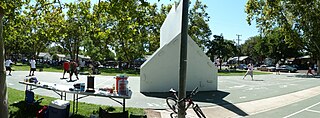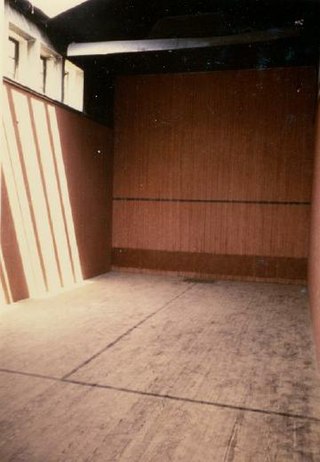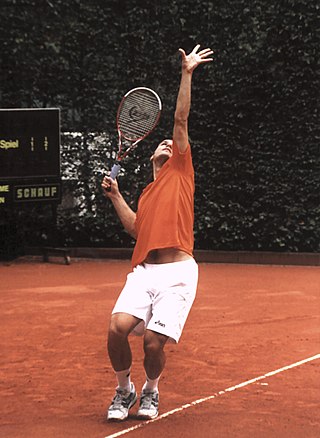
Badminton is a racquet sport played using racquets to hit a shuttlecock across a net. Although it may be played with larger teams, the most common forms of the game are "singles" and "doubles". Badminton is often played as a casual outdoor activity in a yard or on a beach; formal games are played on a rectangular indoor court. Points are scored by striking the shuttlecock with the racquet and landing it within the other team's half of the court.

Table tennis is a racket sport derived from tennis but distinguished by its playing surface being atop a stationary table, rather than the court on which players stand. Either individually or in teams of two, players take alternating turns returning a light, hollow ball over the table's net onto the opposing half of the court using small rackets until they fail to do so, which results in a point for the opponent. Play is fast, requiring quick reaction and constant attention, and is characterized by an emphasis on spin relative to other ball sports, which can heavily affect the ball's trajectory.

Racquetball is a racquet sport and a team sport played with a hollow rubber ball on an indoor or outdoor court. Joseph Sobek invented the modern sport of racquetball in 1950, adding a stringed racquet to paddleball in order to increase velocity and control. Unlike most racquet sports, such as tennis and badminton, there is no net to hit the ball over, and, unlike squash, no tin to hit the ball above. Also, the court's walls, floor, and ceiling are legal playing surfaces, with the exception of court-specific designated hinders being out-of-bounds. Racquetball is played between various players on a team who try to bounce the ball with the racquet onto the ground so it hits the wall, so that an opposing team’s player cannot bounce it back to the wall.

Squash, sometimes called squash rackets, is a racket-and-ball sport played by two (singles) or four players (doubles) in a four-walled court with a small, hollow, rubber ball. The players alternate in striking the ball with their rackets onto the playable surfaces of the four walls of the court. The objective of the game is to hit the ball in such a way that the opponent is not able to play a valid return. There are about 20 million people who play squash regularly world-wide in over 185 countries. The governing body of squash, the World Squash Federation (WSF), is recognized by the International Olympic Committee (IOC), and the sport is included in the Olympic Games, after a number of applications. Squash has been added for the 2028 Summer Olympics in Los Angeles. The Professional Squash Association (PSA) organizes the pro tour.

Real tennis – one of several games sometimes called "the sport of kings" – is the original racquet sport from which the modern game of tennis is derived. It is also known as court tennis in the United States, royal tennis in England and Australia, and courte-paume in France. Many French real tennis courts are at jeu de paume clubs.

Rugby fives is a handball game, similar to squash, played in an enclosed court. It has similarities with Winchester fives and Eton fives. It is played mainly in the United Kingdom.

American handball, known as handball in the United States and sometimes referred to as wallball, is a sport in which players use their hands to hit a small, rubber ball against a wall such that their opponent(s) cannot do the same without the ball touching the ground twice or hitting out-of-bounds. The three versions are four-wall, three-wall and one-wall. Each version can be played either by two players (singles), three players (cutthroat) or four players (doubles), but in official tournaments, singles and doubles are the only versions played.

Squash tennis is an American variant of squash, one played with a ball and racquets that are more similar to the equipment used for lawn tennis, and with somewhat different rules. The game offers the complexity of squash and the speed of racquetball.

Pickleball is a racket or paddle sport in which two players (singles) or four players (doubles) hit a perforated, hollow plastic ball with paddles over a 34-inch-high (0.86 m) net until one side is unable to return the ball or commits a rule infraction. Pickleball is played indoors and outdoors. It was invented in 1965 as a children's backyard game in the United States, on Bainbridge Island in Washington state. In 2022, pickleball was named the official state sport of Washington.
A point in tennis is the smallest subdivision of the match. A point can consist of a double fault by the server, in which case the point is automatically won by the receiver. In all other cases, a point begins when a legal serve is hit by the server to the receiver on the opposite side of the court, and continues until one side fails to legally return the ball to the opposite side. Whichever side fails to do so loses the point and their opponent wins it.
This page is a glossary of tennis terminology.

Ball badminton is a sport native to India. It is a racket sport game, played with a yellow ball made of wool, on a court of fixed dimensions divided by a net. The game was played as early as 1856 by the royal family in Tanjore, the capital of Thanjavur district in Tamil Nadu, India. It enjoys the greatest popularity in India. Ball badminton is a fast-paced game; it demands skill, quick reflexes, good judgment, agility, and the ability to control the ball with one's wrist.
Traditionally, tennis is played between two people in a singles match, or two pairs in a doubles match. Tennis can also be played on different courts, including grass courts, clay courts, hard courts, and artificial grass courts.

Wallball,, is a team sport played between a various number of players per team in which players hit a bouncy ball against a wall, using their hands. The game requires the ball to be hit to the floor before hitting the wall, but in other respects is similar to squash. One player on one team may bounce the ball against the wall so a player only on the opposing team cannot bounce it back to the wall. The last person to be holding the ball after everyone is out is the winner, and their team immediately wins the game. The game requires lots of motion, and especially benefits young athletes when playing mostly at schools.

A serve in tennis is a shot to start a point. A player will hit the ball with a racquet so it will fall into the diagonally opposite service box without being stopped by the net. Normally players begin a serve by tossing the ball into the air and hitting it. The ball can only touch the net on a return and will be considered good if it falls on the opposite side. If the ball contacts the net on the serve but then proceeds to the proper service box, it is called a let; this is not a legal serve in the major tours although it is also not a fault. Players normally serve overhead; however serving underhand is allowed. The serve is the only shot a player can take their time to set up instead of having to react to an opponent's shot; however, as of 2012, there is a 25-second limit to be allowed between points.
Handball is a children's ball game widely documented in Australian schools, similar to downball. The rules of the game vary considerably across different sites and conditions, but it is generally played on a flat game court with lined square zones, and involves at least two players, who each occupies a square and take turns hitting a ball with their bare hands into other player's square(s). The game is very easy to set up and can be conveniently adapted to any environments where square/rectangular-lined flat grounds can be found, such as other gyms/arenas, parking spaces and even concrete slabbed driveways and footpaths.
Table squash is a sport for two players which is an evolution of table tennis and uses similar rules and equipment. The game is played by placing a table tennis table against a playing wall with the net remaining on the table perpendicular to the wall. Each player stands on the opposite side of the table facing the wall on either side of an imaginary line as if the net was extended backwards. Players each use table tennis rackets and take turns to play a table tennis ball off the playing wall onto the table on the opponents side of the net, except on serves where the ball must first bounce on the servers side of the net on the table.

Roundnet is a ball game created in 1989 by Jeff Knurek, inspired primarily by concepts from volleyball. The game is played between two teams, usually with two players each. Players initially line up around a small trampoline-like net at the start of a point and starts with a serve from one team to another. Teams alternate hitting the ball back to the net.
This glossary provides definitions and context for terminology related to, and jargon specific to, the sport of pickleball. Words or phrases in italics can be found on the list in their respective alphabetic sections.













